Millions of people around the world are celebrating Chinese New Year on Monday, the first day of the Year of the Monkey.
To help those who are not familiar with the holiday, CTVNews.ca looks at five different traditions associated with the celebration and the meaning behind them.
1. Salutations: Many Chinese speakers greet each other during the New Year with the popular phrase "Kung Hei Fat Choi" in Cantonese, and "Gong Xi Fa Cai" in Mandarin. While commonly believed to mean "Happy New Year," the greeting is more akin to wishing someone happiness and prosperity in the coming year.
The phrase "Sun Nien Fai Lok" in Cantonese, and "Xin Nian Kuai Le" in Mandarin, are a closer translation of the phrase "Happy New Year." During the celebration, many Chinese households will post red and gold banners with these phrases written on them on their walls and front doors.
2. Firecrackers and lion dances: Elaborate firework displays are set off in many Asian cities during the New Year, and many Chinese families have displays in their home featuring mock firecrackers made out of cardboard and paper. Angela Chan, vice-president of the Chinese Cultural Centre of Greater Toronto, told CTV’s Canada AM that firecrackers are used during the celebrations because of the loud cracking and popping noises they make. These noises are meant to drive away negative or "evil" spirits, Chan said.
Similarly, the popular lion dance tradition is also meant help drive away evil spirits, Chan said.


3. Flowers: Displaying flowers is another common Chinese New Year tradition, with peonies and plum blossoms being especially popular. Both flowers symbolize prosperity, Chan says, and one can consider themselves very lucky if their plum blossom happens to bloom during the New Year celebration.

4. Cleaning house: Leading up to the New Year, many Chinese households will spend time cleaning their house from top to bottom. Chan said the act of cleaning symbolizes ridding your home of any bad luck. "We want to sweep away the bad luck, and welcome the good luck," she said.
5. Red envelopes: Red envelopes containing money are commonly given out during many festive occasions, including weddings and baby showers. However, the practice is amplified during Chinese New Year, when, as per tradition, they are given to younger generations by their parents, grandparents and other relatives.
A popular GIF circulating on social media jokes that for many younger Chinese people, the New Year festivities can often feel like this:

The red envelopes are meant to symbolize wishes of good luck, and in some Asian countries local businesses will give red envelopes to their patrons.




























